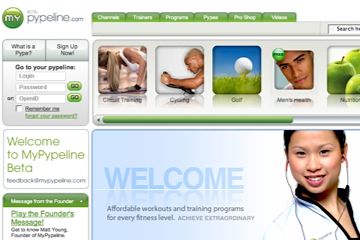 Via Web Fugitive : My Pypeline is an interesting blend of several online fitness services and social networks. With demonstration videos, virtual training services and a number of tracking tools; this is definitely one to check out.
Via Web Fugitive : My Pypeline is an interesting blend of several online fitness services and social networks. With demonstration videos, virtual training services and a number of tracking tools; this is definitely one to check out.
Results matching “Bird”
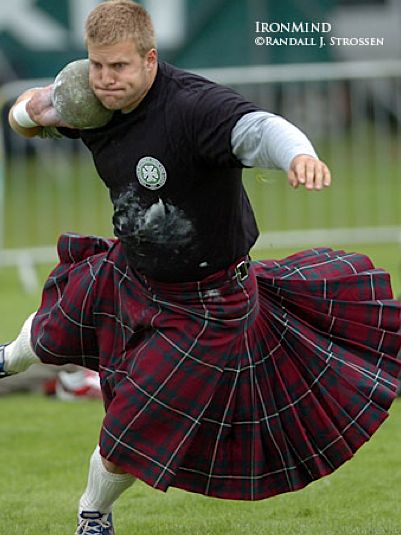
Via IronMind : British shotput champion Scott Rider competing in - and winning - last year's Highland Gathering at Braemar.
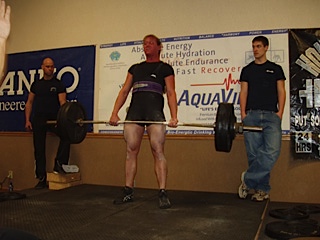 This is a guest post by bodybuilder, writer and lover of all forms of fitness - Kat 'The Mighty Kat' Ricker.
This is a guest post by bodybuilder, writer and lover of all forms of fitness - Kat 'The Mighty Kat' Ricker.
Interview on the Deadlift with World Champion Christine Neff.
World Champion deadlifter Christine Neff (formerly Rovnak) is one of the few women in the world who can deadlift more than 500 pounds. She has been powerlifting for 11 years and competing on and off for nine. She holds world, national and state powerlifting records in various weightlifting classes in various federations.
And, I'm proud to say, she's my sister.
 Stats
Stats
Age: 27
Height/weight: 5'11" 192 pounds
Hometown: Coeur d'Alene, ID
Has competed with: WABDL, APA, APF, USAPL, AAU, USPF
Stats: World record 502.6 pound deadlift in 2007 for WABDL in the open women's 198 pound class, signed by Gus Rethwisch.
Bench 315 pounds at 181 assisted, 275 pounds at 181 raw; Squat 440#. For more details on competition history, see bottom.
Did you set out to become a world record holder in this lift?
Not at all. The fact that I hold the world record is still surreal to me. I am one of a few women in the world pulling over 500#, yet I am always surprised when people walk up to me after a competition with compliments and handshakes.
Did this lift come easy to you? How long until you felt competent?
The deadlift HAS always come easier to me than the other lifts. Compared to bench pressing, I have had to train very little to get where I am now. Unfortunately, knowing this has allowed me to be lazy and (give me) the feeling that achievement is constantly just out of my grasp.
Is the deadlift your favorite lift? If so, was it always?
Absolutely. Deadlifting is, in some circles, considered to be the bluecollar lift of the powerlifting world.
During the beginning stages of my competing, I did not deadlift. People are rarely seen training this lift, and a normal gym setting can be an embarrassing place to do it, especially to someone who doesn't know what they are doing. I was somewhat influenced to try it after watching several very strong women pull at the end of our competitions.
It is not as popular, nor can it be as easily influenced by the use of supportive gear. Take benchpressing for example. In the 80s and early 90s men benching in the 500-600 pound range were elite. Somewhere along the line, someone got the idea to change the single-ply bench shirt into scientific armor. We went from having denim then double-denim, to lifters wearing shirts 3x too small for them with 4 inches of stitching across their chest and a split down the back. I read an interview from a girl who benched just below 400 pounds openly admitting that she gets at least half of that from her shirt. Now I watch amateur lifters in the gym spending money on shirts before they even have their true form down, and lifters shattering their forearms in competition because they were not built to support upwards of 800-1000#.
There is a time and place for everything, and whether someone lifts equipped or not is their decision. In many competitions, I too wear a shirt (though drawing the line at a double poly), but feel the deadlift is more raw in form. Deadlift suits cannot add 100# to your pull, and training without a partner is possible. At a competition everyone shows up to watch the bench, but the Lifters are the ones left watching at the end.
Describe your training, and how it differs between on and off-season.
I am a strong believer that heavy lifting is mostly done in the mind. If you allow your body to soften up during "offseason", you take the chance of coming back weaker and less enthusiastic than you would have been if you'd stayed disciplined and focused.
Training the deadlift is different than the other lifts in the sense that overtraining is very easy to do, and for that reason, I do actual deadlifts only leading up to a competition or occasionally on a back night at moderately heavy weights.
If I deadlift every week, I find my body and mind becoming bored. Instead, I focus on working my hips on the sled or by doing squats/hack squats. My grip leaves something to be desired, so I also do forearms and try to keep the rest of my body tight.
About 6-8 weeks from a competition, I will begin doing heavy deadlifts twice a week. On the first night, I use the same form as I would in competition. On the second (about 3 days later), I like to stand on a platform or plates and do hyperextensions. Both nights I do sets 6" above and 6" below the knee from the Smith Machine with weights I normally wouldn't be able to pick off the ground with the intent to work the sticking points and refining my form. Additionally, I move my focus away from arm exercises and anything not directly tied to the deadlift. The last week before competition, I stop deadlifting altogether and give my body time to rest.
Does your philosophical approach to deadlifting differ between the on and off-season?
I am ALWAYS working to shatter my previous records in competition, but I seem to do worse if I train the deadlift every week. My focus is pointed more at keeping everything strong all the time and training the deadlift primarily leading up to a competition.
What goes through your head while you're executing a deadlift?
Clear your head and walk up to the bar like you hate it. Ignore the crowd, and don't look down when you place your hands. Take a deep breath in, bend your knees, and set your hands. Push down with your legs and roll your shoulders while exhaling, pull with all your might. Then try not to pass out.
What are the biggest mistakes you see others make in their deadlifts?
Form is a real killer in the deadlift. Some people are gifted with bull muscle strength and have the ability to pull up great amounts with their knees locked and backs bent. Eventually, however, the increasing amount of weight can cripple the spine. Having a firm stance and utilizing the large muscle groups in the legs and pelvis will allow for steady improvement and keep a body healthier in the long run.
Are the mistakes generally the same between regular lifters and competitors?
I think competitors are less likely to have sloppy form because they can appreciate the lift from a judging point of view. However, there are always a few, both competitors and regular lifters, more concerned about showing off than the gradual climb to core strength. This probably has more to do with individual personality, but does not improve ability to lift in any way and annoys the rest of us in the gym.
What was the best piece of advice you ever got on your deadlift?
My husband Roger, who has taught me almost everything I've talked about so far, told me to relax and stop thinking so much.
I had to learn the hard way that nagging myself to death to do better can be sabotage.
You cannot become discouraged when a particular night in the gym yields less weight than it did the night or week before. Daily activities, diet, and frame of mind directly affect the ability to lift and the more you think about how badly you are doing, the worse you do.
An example of battling my expectations happened just before I broke the world record. I had been out of lifting for too long and became easily discouraged. When I wasn't rapidly progressing, I beat my self up mentally. It had gotten so bad that the last session in the gym before the competition I couldn't even budge 465# off the floor, which was 20# lighter than I'd been lifting the week before!
After getting a firm talking to and taking a week off, the day of competition came. I kept my head clear and allowed my training to take over...then pulled the best numbers of my life.
Adrenaline can do wonders, so don't worry if you haven't pulled what you want to in practice. Training in a family gym, probably listening to music that is not your choice, and being stared at by parents or teenagers that have no idea what you are doing is much different than standing under the lights on a stage covered in sweat and chalk looking out over a crowd.
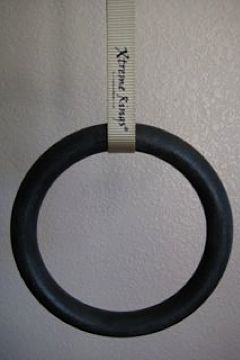 I was just about to grab a pair of rings, when I noticed Shaf's initial review of the Xtreme offering. Sounds great.
I was just about to grab a pair of rings, when I noticed Shaf's initial review of the Xtreme offering. Sounds great.
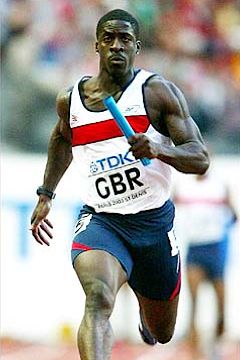 The Science of Sport takes a great look at the revived career of Dwain Chambers. Incidentally, I agree with the first commenter - it's quite possible to improve markedly without the use of illegal substances.
The Science of Sport takes a great look at the revived career of Dwain Chambers. Incidentally, I agree with the first commenter - it's quite possible to improve markedly without the use of illegal substances.
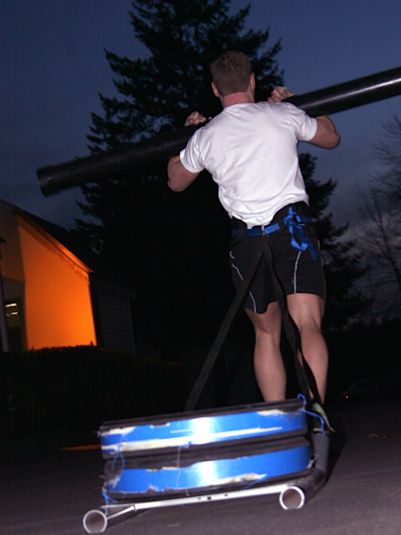
Via CrossFit Eastside : a little slosh-pipe and sled work. Great combo.
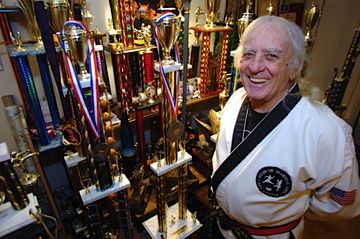 Via MMA Updates : Washington's Tom Sulick Sr is still competing in - and winning - karate tournaments at a spritely 75. Excellent.
Via MMA Updates : Washington's Tom Sulick Sr is still competing in - and winning - karate tournaments at a spritely 75. Excellent.
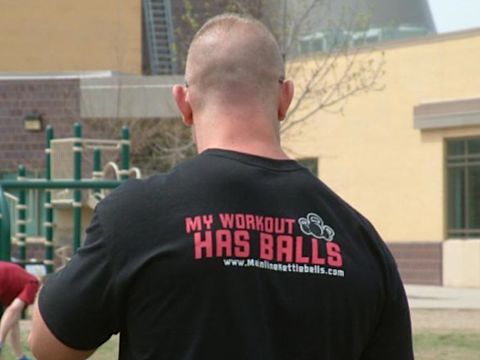 This month, Run To Win and Straight to the Bar will be looking at the many possibilities when it comes to home-made training equipment. This week, I'll be taking a look at several great conditioning tools - DIY Balls.
This month, Run To Win and Straight to the Bar will be looking at the many possibilities when it comes to home-made training equipment. This week, I'll be taking a look at several great conditioning tools - DIY Balls.
Slammable Medicine Balls
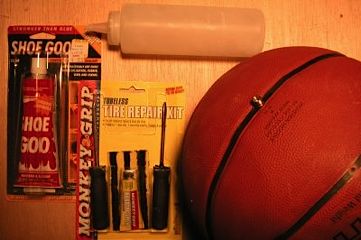 These have been made many, many times; the first one I saw was Jim's over at Lean and Hungry Fitness. Jim has the details on the technique, but here's the short version :
These have been made many, many times; the first one I saw was Jim's over at Lean and Hungry Fitness. Jim has the details on the technique, but here's the short version :
- buy a cheap, deflated ball from a sporting goods store
- cut the opening a little wider (a cross will do fine, about 1/2" across)
- pour in the filling (usually sand) - using a funnel - until the ball's about 3/4 full
- fill the remainder with expanding foam, seal it with duct tape and let it sit overnight
- when hardened, trim off any excess foam and retape
- the ball is now ready for use
Tornado Ball
A while ago Paul Chek and Bryan Walsh wrote about the idea of a Tornado Ball, which is really just a Medicine Ball and a short cord. Once you've made the Medicine Ball above, grab an old bag or hessian sack and try this (video via the Diesel Crew).
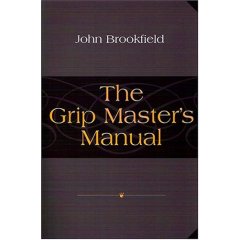 In the Grip Master’s Manual, a book I think anyone interested in grip strength should read, John Brookfield mentions that one of the secrets to closing heavy grippers, especially the IronMind Captains of Crush grippers, is strength in the last two fingers, or the ring and pinky fingers. He says that strength in these two fingers is what finishes off the close when making a big attempt. I fully agree.
In the Grip Master’s Manual, a book I think anyone interested in grip strength should read, John Brookfield mentions that one of the secrets to closing heavy grippers, especially the IronMind Captains of Crush grippers, is strength in the last two fingers, or the ring and pinky fingers. He says that strength in these two fingers is what finishes off the close when making a big attempt. I fully agree.
After analyzing my performance over the last couple of years in grip contests, I have identified grippers as one of the events I must work on. Aside from other methods I have been using to bring my crush up, I have been supplementing my normal gripper work with lots of focus on the last two fingers.
There is a multitude of ways to work the last two fingers but I want to share some of the things that I have been doing routinely to work on the last two.
 One thing that I have been using is the IronMind Tug #5. The IronMind Tugs are shorter-handled torsion-spring grippers that are designed specifically with the last two fingers in mind. I will perform repetitions with the Tug #5 and holds for time, each day I do gripper work. The Tug #5 started out tough for me but after much work on it and probably due to some seasoning, it has gotten rather easy and I am considering buying the next level up in an effort to keep progressing on grippers.
One thing that I have been using is the IronMind Tug #5. The IronMind Tugs are shorter-handled torsion-spring grippers that are designed specifically with the last two fingers in mind. I will perform repetitions with the Tug #5 and holds for time, each day I do gripper work. The Tug #5 started out tough for me but after much work on it and probably due to some seasoning, it has gotten rather easy and I am considering buying the next level up in an effort to keep progressing on grippers.
 Another tactic I have implemented is called choking. Choking is where you secure the gripper handles down with an object so that they are partially closed. This can be done with a PDA choker, a large washer, or a hose clamp, which is what I use. Hose clamps cost about $1.50 at the hardware store and are a very cheap yet functional option for gripper choking.
Another tactic I have implemented is called choking. Choking is where you secure the gripper handles down with an object so that they are partially closed. This can be done with a PDA choker, a large washer, or a hose clamp, which is what I use. Hose clamps cost about $1.50 at the hardware store and are a very cheap yet functional option for gripper choking.
 I have choked down a #1 Captains of Crush gripper to the point that the handles are parallel.
I have choked down a #1 Captains of Crush gripper to the point that the handles are parallel.
 Then, I invert it, like a Tug, and make attempts to close it with only my last two fingers. I have not yet been able to touch the handles together with my last two fingers, but I am down to about a sixteenth of an inch and if I cheat the handles shut and then remove my off hand, I can hold it nearly closed.
Then, I invert it, like a Tug, and make attempts to close it with only my last two fingers. I have not yet been able to touch the handles together with my last two fingers, but I am down to about a sixteenth of an inch and if I cheat the handles shut and then remove my off hand, I can hold it nearly closed.
Also, I have been working my last two fingers in a static fashion by pinching together the handles of two sledgehammers.

 I normally perform timed holds with this lift, but I also like to pinch and lift the sledges and then swing the handles back and forth, perform figure eights, and twists with the sledges aloft. This is a great finisher to your last two finger training.
I normally perform timed holds with this lift, but I also like to pinch and lift the sledges and then swing the handles back and forth, perform figure eights, and twists with the sledges aloft. This is a great finisher to your last two finger training.
I strongly suggest you implement some last two training if your goal is to close heavy grippers, but I will warn you that the day or two after you perform lifts that isolate the last two, your pinky pad will be sore. This pain will subside soon enough and you can speed your recovery by performing deep tissue massage on yourself, doing contrast bathing, and with thorough stretching.
All the best in your training.
"Napalm" Jedd Johnson
DieselCrew.com
Napalm's Blog

